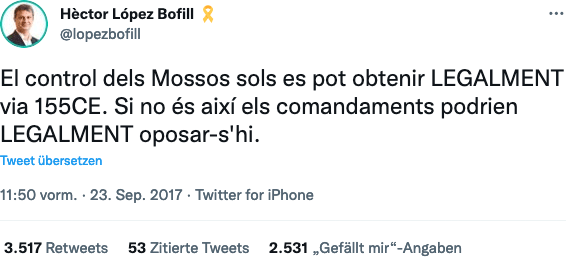Während Südtiroler Tageszeitungen das harte Vorgehen des spanischen Nationalstaats gegen Katalonien — zumindest auf den Titelseiten — ignorierten, erschien bei Zeit Online ein einschlägiger Artikel von Ulrich Ladurner. Diesen empörenden Beitrag des Südtiroler Journalisten möchte ich hier auszugsweise kommentieren.
Die Katalanen treiben das fragwürdige Referendum über ihre Unabhängigkeit voran, Eskalation inklusive. Ihr undemokratisches Vorgehen zwingt Madrid zu harten Reaktionen.
- Erste Frage: Haben wirklich die Katalaninnen eskaliert? Oder war es vielleicht doch der Zentralstaat (der zuvor übrigens jegliche Verhandlung über ein Referendum abgelehnt hatte)?
- Zweite Frage: Was genau ist am Vorgehen der katalanischen Regierung, die eine Volksabstimmung und keinen gewaltsamen Putsch organisiert, undemokratisch?
- Dritte Frage: Meint Ladurner tatsächlich, dass Madrid zu einer Vorgehensweise gezwungen war, die nun international von Politiker-, Bürgerrechtlerinnen und Medien scharf kritisiert wurde?
Am 6. September verabschiedete das katalanische Regionalparlament ein Gesetz, das den Weg für ein Unabhängigkeitsreferendum frei machen sollte. 60 Abgeordnete stimmten dagegen, 72 stimmten dafür. Das war schon ein Zeichen dafür, dass selbst die katalanische Gesellschaft in dieser Frage tief gespalten ist.
Es stimmten 72 Abgeordnete dafür, 11 enthielten sich und alle weiteren nahmen an der Abstimmung gar nicht teil. Ist »tiefe Spaltung« in einer Demokratie nicht quasi ein Normalzustand? Was wäre die Alternative? Dass sich die Mehrheit von 72 einer (nicht abstimmenden) Minderheit unterordnet?
Darüberhinaus ist doch zu sagen, dass da nicht die Abspaltung beschlossen wurde, sondern die Befragung der Bevölkerung mithilfe eines demokratischen Verfahrens wie dem Referendum.
Doch Puigdemonts Regierung kümmerte das nicht. Sie peitschte das Gesetz innerhalb von 48 Stunden durch das Parlament. Zeit für eine ausgiebige Debatte über eine so existenzielle Frage wie die Unabhängigkeit gab es nicht.
Stimmt. Ideal ist das nicht. Hätte der Zentralstaat eine Abstimmung mitgetragen, hätte man ähnlich wie in Schottland eine längere Vorlaufzeit mit parlamentarischen und außerparlamentarischen Debatten einplanen können. Nachdem das Interesse von Madrid jedoch nicht einer sauberen Durchführung, sondern der Verhinderung galt, musste man diesbezüglich Kompromisse eingehen. Man hatte es ja schon mehrmals versucht.
Doch in Katalonien wird schon seit Jahren (im Parlament und außerhalb) über die Selbstbestimmung diskutiert, weshalb zwar diese parlamentarische Debatte kurz ausfiel, aber im Laufe der Jahre doch genug Zeit vorhanden war, die unterschiedlichen Positionen zum Ausdruck zu bringen.
“Das Referendum wird niemals stattfinden”, sagte Ministerpräsident Mariano Rajoy deshalb und rief die katalanische Regierung zur Umkehr auf. Doch die machte immer weiter.
Warum nennt Ladurner Rajoy, anders als die Katalaninnen, nicht ebenfalls undemokratisch? Oder ist das ewige Verbot eines Referendums (»niemals«!) etwa demokratisch?
Dann schritt die Polizei ein. […] Das geschah nicht, wie Puigdemont glauben machen will, weil von der Zentralregierung der “De-facto Ausnahmezustand” ausgerufen worden sei. Das geschah auf Anordnung eines Richters in Barcelona, der sich veranlasst sah, gegen die Vorbereitung eines illegalen Referendums vorzugehen. Doch diese wichtigen Differenzierungen gehen jetzt unter.
Erstens hatte die spanische Regierung kurz zuvor beschlossen, das katalanische Wirtschaftsministerium »auszuschalten« und zweitens ist es ein offenes Gehemnis, dass in dieser Frage Gerichte, Zentralregierung und Geheimdienste »zusammenarbeiten«. Diese Konspiration hat sogar schon den UN-Sonderbeauftragten für Menschenrechte auf den Plan gerufen. Doch diese wichtigen Details und Differenzierungen gehen jetzt unter.
Es geht auch unter, dass die katalanische Regierung das Referendum nicht gerade demokratisch ausgestaltet hat. Es sieht keine Mindestbeteiligung vor. Und es gilt die relative Mehrheit. Wenn also beispielsweise nur 20 Prozent der Katalanen abstimmten, und davon 50 Prozent plus 1 mit Ja votierten, hätte eine kleine Minderheit der Katalanen eine neue Republik geschaffen.
Ein Referendum, das diesbezüglich den Ratschlägen der Venedig-Kommission des Europarats folgt, ist laut Herrn Ladurner also »nicht gerade demokratisch ausgestaltet«.
In Punkt 7 des Code of Good Practice on Referendums empfiehlt die Venedig-Kommission ausdrücklich, von Beteiligungs- und Zustimmungsquora abzusehen.
Das Schlimme an der jetzigen Lage: Rajoys berechtigtes Bestehen auf die Grundlagen der repräsentativen Demokratie klingt in der Hitze der Emotionen wie eine Kampfansage an das katalanische Volk.
Nun ja… auch ein »berechtigtes Bestehen« kann eben eine Kampfansage sein, wenn man außerstande ist, politische Verhandlungen zu führen und völlig unverhältnismäßige Gegenmaßnahmen ergreift.
Cëla enghe: 01 02 03 04


Katalonien